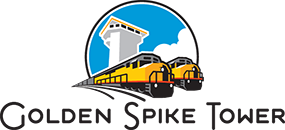During the construction of the transcontinental railroad, North Platte was platted as a railroad town by Union Pacific’s Chief Engineer Grenville Dodge. It was chosen because of its close proximity to good water, and its distance from Grand Island, Nebraska. In 1866 the first train rolled through what was known at the time as “Hell on Wheels” town. General Dodge quickly moved to construct major shop facilities and winter quarters and by 1867, main line operations began. Just two years later on May 10th, East met West at Promontory Summit in Utah, 690 miles east Sacramento and 1,087 miles west of Omaha. The railroad crossed two-thirds of the continent over some of the most difficult terrain on earth. It was called, “The Work of Giants” and it was the end of the frontier, as we knew it.

General Grenville Dodge,
Engineer for Union Pacific.
Buffalo Bill’s Home Base
In the late 1800s and early 1900s, North Platte became home to Buffalo Bill Cody’s Scouts Rest Ranch because of its proximity to the railroad. Able to move his Wild West Show by train or by wagon from this location, Buffalo Bill’s Wild West Show entertained throughout the U.S. and performed in front of heads of state
throughout the world.
WWII On The Homefront
From 1941 to 1946, The North Platte Canteen served more than six million members of the armed forces providing home baked goods and a warm welcome to the nation’s young men and women as they passed by for a 10-minute stop. The nation was at war, and the volunteers at the North Platte Canteen stepped up to give each serviceperson a welcome break from going to or returning from the war.
End Of An Era
Passenger rail service was discontinued in 1971 after operating for some 105 years. Gone are the days of Pullman sleeping cars, dining cars, lounges and coaches. The romance and luxury of passenger trains was done in by automobiles and air travel.
Today Bailey Yard, named for former Union Pacific president Edd H. Bailey, is the world’s largest train yard. Covering a massive 2,850 acres, each day Bailey Yard manages 10,000 railroad cars. Of those, 3,000 are sorted to make sure the cargo reaches its final destination. You can see it all from the Golden Spike Tower and Visitor Center in North Platte.
Union Pacific’s Bailey Yard in North Platte, Nebraska is the largest railroad classification yard in the world. Named in honor of former Union Pacific President Edd H. Bailey, the massive yard covers 2,850 acres, reaching a total length of eight miles. The yard is located in the midst of key east-west and north-south corridors, on the busiest freight rail line in America, making it a critical component of Union Pacific’s rail network.
Bailey Yard has 17 receiving and 16 departure tracks handling 14,000 rail cars every 24 hours. 3,000 cars are sorted daily in the yard’s eastward and westward yards, nicknamed “hump” yards. Using a mound cresting 34 feet for eastbound trains and 20 feet for those heading west, the hump yards allow four cars a minute to roll gently into any of 114 “bowl” tracks. Here they become part of trains headed for destinations in the East, West and Gulf Coasts of America, as well as the Canadian and Mexican borders. An average of 139 trains per day are largely comprised of raw and finished goods, such as automobiles, coal, grain, corn, sugar, chemicals, and steel along with consumer goods, including electronics, apparel and other retail products.
To keep America moving forward, the train operations and repair shops at Bailey Yard are open 24 hours a day, seven days a week. The fueling and service center processes more than 8,500 locomotives each month, using technology like overhead cranes and elevated work bays to maintain fluid operations.
On-Site Car Repair
The on-site car repair facility annually replaces 10,000 pairs of wheels, many identified through an in-motion defect detector using ultrasound technology to inspect the wheel. This detector was developed by Union Pacific and is the only one in the world. Some wheel repairs even take place without the rail car ever leaving the track, minimizing down time.
Union Pacific’s annual capital investments continue to enhance operational capabilities at Bailey Yard, ensuring safe, reliable and environmentally friendly transportation.
Command Center
All train movement throughout Bailey Yard is handled through the on-site command center with the latest computerized control systems. The Bailey Yard command center is tied to the Harriman Dispatching Center in Omaha, which controls hundreds of intercity trains daily throughout the company’s 23-state rail system.


